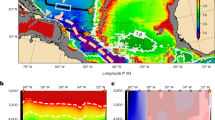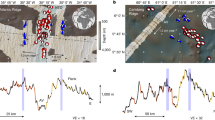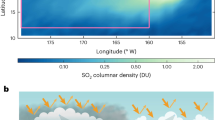Abstract
Mass loss from the Amundsen Sea sector of the West Antarctic Ice Sheet has increased in recent decades, suggestive of sustained ocean forcing or an ongoing, possibly unstable, response to a past climate anomaly. Lengthening satellite records appear to be incompatible with either process, however, revealing both periodic hiatuses in acceleration and intermittent episodes of thinning. Here we use ocean temperature, salinity, dissolved-oxygen and current measurements taken from 2000 to 2016 near the Dotson Ice Shelf to determine temporal changes in net basal melting. A decadal cycle dominates the ocean record, with melt changing by a factor of about four between cool and warm extremes via a nonlinear relationship with ocean temperature. A warm phase that peaked around 2009 coincided with ice-shelf thinning and retreat of the grounding line, which re-advanced during a post-2011 cool phase. These observations demonstrate how discontinuous ice retreat is linked with ocean variability, and that the strength and timing of decadal extremes is more influential than changes in the longer-term mean state. The nonlinear response of melting to temperature change heightens the sensitivity of Amundsen Sea ice shelves to such variability, possibly explaining the vulnerability of the ice sheet in that sector, where subsurface ocean temperatures are relatively high.
This is a preview of subscription content, access via your institution
Access options
Access Nature and 54 other Nature Portfolio journals
Get Nature+, our best-value online-access subscription
$29.99 / 30 days
cancel any time
Subscribe to this journal
Receive 12 print issues and online access
$259.00 per year
only $21.58 per issue
Buy this article
- Purchase on Springer Link
- Instant access to full article PDF
Prices may be subject to local taxes which are calculated during checkout





Similar content being viewed by others
References
Shepherd, A. et al. A reconciled estimate of ice-sheet mass balance. Science 338, 1183–1189 (2012).
Fretwell, P. et al. Bedmap2: improved ice bed, surface and thickness datasets for Antarctica. Cryosphere 7, 375–393 (2013).
Schoof, C. Ice sheet grounding line dynamics: steady states, stability, and hysteresis. J. Geophys. Res. 112, F03S28 (2007).
Goldberg, D., Holland, D. M. & Schoof, C. Grounding line movement and ice shelf buttressing in marine ice sheets. J. Geophys. Res. 114, F04026 (2009).
Gudmundsson, G. H. Ice-shelf buttressing and the stability of marine ice sheets. Cryosphere 7, 47–655 (2013).
Reese, R., Gudmundsson, G. H., Levermann, A. & Winkelmann, R. The far reach of ice-shelf thinning in Antarctica. Nat. Clim. Change 8, 53–57 (2018).
Mouginot, J., Rignot, E. & Scheuchl, B. Sustained increase in ice discharge from the Amundsen Sea Embayment, West Antarctica, from 1973 to 2013. Geophys. Res. Lett. 41, 1576–1584 (2014).
Scheuchl, B., Mouginot, J., Rignot, E., Morlighem, M. & Khazendar, A. Grounding line retreat of Pope, Smith, and Kohler Glaciers, West Antarctica, measured with Sentinel-1a radar interferometry data. Geophys. Res. Lett. 43, 8572–8579 (2016).
Konrad, H. et al. Uneven onset and pace of ice-dynamical imbalance in the Amundsen Sea Embayment, West Antarctica. Geophys. Res. Lett. 44, 910–918 (2017).
Thomas, R. H., Sanderson, T. J. O. & Rose, K. E. Effect of climatic warming on the West Antarctic ice sheet. Nature 277, 355–358 (1979).
Jacobs, S. S., Hellmer, H. H. & Jenkins, A. Antarctic ice sheet melting in the southeast Pacific. Geophys. Res. Lett. 23, 957–960 (1996).
Paolo, F. S., Fricker, H. A. & Padman, L. Volume loss from Antarctic ice shelves is accelerating. Science 348, 327–331 (2015).
Favier, L. et al. Retreat of Pine Island Glacier controlled by marine ice-sheet instability. Nat. Clim. Change 4, 117–121 (2014).
Joughin, I., Smith, B. E. & Medley, B. Marine ice sheet collapse potentially under way for the Thwaites Glacier basin, West Antarctica. Science 344, 735–738 (2014).
Smith, J. A. et al. Sub-ice shelf sediments record 20th century retreat history of Pine Island Glacier. Nature 541, 77–80 (2017).
Hillenbrand, C.-D. et al. West Antarctic Ice Sheet retreat driven by Holocene warm water incursions. Nature 547, 43–48 (2017).
Schmidtko, S., Heywood, K. J., Thompson, A. F. & Aoki, S. Multidecadal warming of Antarctic waters. Science 346, 1227–1231 (2014).
Jacobs, S. S., Jenkins, A., Giulivi, C. F. & Dutrieux, P. Stronger ocean circulation and increased melting under Pine Island Glacier ice shelf. Nat. Geosci. 4, 519–523 (2011).
Dutrieux, P. et al. Strong sensitivity of Pine Island ice-shelf melting to climatic variability. Science 343, 174–178 (2014).
Webber, B. G. M. et al. Mechanisms driving variability in the ocean forcing of Pine Island Glacier. Nat. Commun. 7, 14507 (2017).
Christianson, K. et al. Sensitivity of Pine Island Glacier to observed ocean forcing. Geophys. Res. Lett. 43, 10817–10825 (2016).
Jenkins, A. et al. Decadal ocean forcing and Antarctic Ice Sheet response: lessons from the Amundsen Sea. Oceanography 29, 106–117 (2016).
Jacobs, S. et al. Getz Ice Shelf melting response to changes in ocean forcing. J. Geophys. Res. Oceans 118, 4152–4168 (2013).
Jacobs, S. et al. The Amundsen Sea and the Antarctic Ice Sheet. Oceanography 25, 154–163 (2012).
Wåhlin, A. K., Yuan, X., Björk, G. & Nohr, C. Inflow of warm Circumpolar Deep Water in the central Amundsen shelf. J. Phys. Oceanogr. 40, 1427–1434 (2010).
Ha, H. K. et al. Circulation and Modification of Warm Deep Water on the central Amundsen shelf. J. Phys. Oceanogr. 44, 1493–1501 (2014).
Rignot, E., Jacobs, S., Mouginot, J. & Scheuchl, B. Ice-shelf melting around Antarctica. Science 341, 266–270 (2013).
Gourmelen, N. et al. Channelized melting drives thinning under a rapidly melting Antarctic ice shelf. Geophys. Res. Lett. 44, 9796–9804 (2017).
Paolo, F. S. et al. Response of Pacific-sector Antarctic ice shelves to the El Niño/Southern Oscillation. Nat. Geosci. 11, 121–126 (2018).
Lilien, D. A., Joughin, I., Smith, B. & Shean, D. E. Changes in flow of Crosson and Dotson ice shelves, West Antarctica, in response to elevated melt. Cryosphere 12, 1415–1431 (2018).
Khazendar, A. et al. Rapid submarine ice melting in the grounding zones of ice shelves in West Antarctica. Nat. Commun. 7, 13243 (2016).
Payne, A. J., Vieli, A., Shepherd, A. P., Wingham, D. J. & Rignot, E. Recent dramatic thinning of largest West Antarctic ice stream triggered by oceans. Geophys. Res. Lett. 31, L23401 (2004).
Scott, J. B. T. et al. Increased rate of acceleration on Pine Island Glacier strongly coupled to changes in gravitational driving stress. Cryosphere 3, 125–131 (2009).
Holland, P. R., Jenkins, A. & Holland, D. M. The response of ice shelf basal melting to variations in ocean temperature. J. Climate 21, 2558–2572 (2008).
Kimura, S. et al. Oceanographic controls on the variability of ice-shelf basal melting and circulation of glacial meltwater in the Amundsen Sea Embayment, Antarctica. J. Geophys. Res. Oceans 122, 10131–10155 (2017).
Turner, J. et al. Atmosphere-ocean-ice interactions in the Amundsen Sea Embayment, West Antarctica. Rev. Geophys. 55, 235–276 (2017).
Thoma, M., Jenkins, A., Holland, D. & Jacobs, S. Modelling Circumpolar Deep Water intrusions on the Amundsen Sea continental shelf, Antarctica. Geophys. Res. Lett. 35, L18602 (2008).
St-Laurent, P., Klinck, J. M. & Dinniman, M. S. Impact of local winter cooling on the melt of Pine Island Glacier, Antarctica. J. Geophys. Res. Oceans 120, 6718–6732 (2015).
Kim, C. S. et al. Is Ekman pumping responsible for the seasonal variation of warm circumpolar deep water in the Amundsen Sea? Cont. Shelf Res. 132, 38–48 (2017).
Steig, E. J., Ding, Q., Battisti, D. S. & Jenkins, A. Tropical forcing of Circumpolar Deep Water inflow and outlet glacier thinning in the Amundsen Sea Embayment, West Antarctica. Ann. Glaciol. 53, 19–28 (2012).
The IMBIE Team. Mass balance of the Antarctic Ice Sheet from 1992 to 2017. Nature 558, 219–222 (2018).
Jenkins, A. The impact of melting ice on ocean waters. J. Phys. Oceanogr. 29, 2370–2381 (1999).
Millan, R., Rignot, E., Bernier, V., Morlighem, M. & Dutrieux, P. Bathymetry of the Amundsen Sea Embayment sector of West Antarctica from Operation IceBridge gravity and other data. Geophys. Res. Lett. 44, 1360–1368 (2017).
Jenkins, A. et al. Observations beneath Pine Island Glacier in West Antarctica and implications for its retreat. Nat. Geosci. 3, 468–472 (2010).
Biddle, L. C., Heywood, K. J., Kaiser, J. & Jenkins, A. Glacial meltwater identification in the Amundsen Sea. J. Phys. Oceanogr. 47, 933–954 (2017).
Nakayama, Y., Schröder, M. & Hellmer, H. H. From Circumpolar Deep Water to the glacial meltwater plume on the eastern Amundsen Shelf. Deep-Sea Res. I 77, 50–62 (2013).
Jenkins, A. & Jacobs, S. S. Circulation and melting beneath George VI Ice Shelf, Antarctica. J. Geophys. Res. 113, C04013 (2008).
Wunsch, C. The North Atlantic general circulation west of 50°W determined by inverse methods. Rev. Geophys. Space Phys. 16, 583–620 (1978).
Jenkins, A. Convection-driven melting near the grounding lines of ice shelves and tidewater glaciers. J. Phys. Oceanogr. 41, 2279–2294 (2011).
Jenkins, A. A simple model of the ice shelf–ocean boundary layer and current. J. Phys. Oceanogr. 46, 1785–1803 (2016).
Little, C. M., Gnanadesikan, A. & Oppenheimer, M. How ice shelf morphology controls basal melting. J. Geophys. Res. 114, C12007 (2009).
Acknowledgements
We are grateful to all cruise participants who assisted in the collection of the data. A.J. and D.S. were supported by core funding from the UK Natural Environment Research Council (NERC) to the British Antarctic Survey’s Polar Oceans Program. P.D. was supported by funding from NERC’s iSTAR Programme through grant NE/J005770/11 and NSF grant 1643285. S.J.’s support included NSF grants ANT06-32282 and 16-44159. Support for S.H.L. and T.W.K. was provided by the Korea Polar Research Institute grant KOPRI PE17060. S.S. was supported by National Science Foundation Office of Polar Programs collaborative grants 0838975 and 1443569.
Author information
Authors and Affiliations
Contributions
A.J., D.S., P.D. and S.J. conceived the study. D.S., S.J., T.W.K., S.H.L., H.K.H. and S.S. planned and led the data collection. D.S., P.D. and T.W.K. processed the data. A.J., D.S. and P.D. undertook the data analyses and derivation of the final results. A.J. prepared the manuscript. All authors discussed the results and implications and commented on the manuscript at all stages.
Corresponding author
Ethics declarations
Competing interests
The authors declare no competing interests.
Additional information
Publisher’s note: Springer Nature remains neutral with regard to jurisdictional claims in published maps and institutional affiliations.
Supplementary information
Supplementary Information
Supplementary Tables 1–3 and Supplementary Figures 1–6.
Rights and permissions
About this article
Cite this article
Jenkins, A., Shoosmith, D., Dutrieux, P. et al. West Antarctic Ice Sheet retreat in the Amundsen Sea driven by decadal oceanic variability. Nature Geosci 11, 733–738 (2018). https://doi.org/10.1038/s41561-018-0207-4
Received:
Accepted:
Published:
Issue Date:
DOI: https://doi.org/10.1038/s41561-018-0207-4
This article is cited by
-
Recent irreversible retreat phase of Pine Island Glacier
Nature Climate Change (2024)
-
Sustained ocean cooling insufficient to reverse sea level rise from Antarctica
Communications Earth & Environment (2024)
-
Amundsen Sea circulation controls bottom upwelling and Antarctic Pine Island and Thwaites ice shelf melting
Nature Communications (2024)
-
A framework for estimating the anthropogenic part of Antarctica’s sea level contribution in a synthetic setting
Communications Earth & Environment (2024)
-
Atlantic Water warming increases melt below Northeast Greenland’s last floating ice tongue
Nature Communications (2024)



